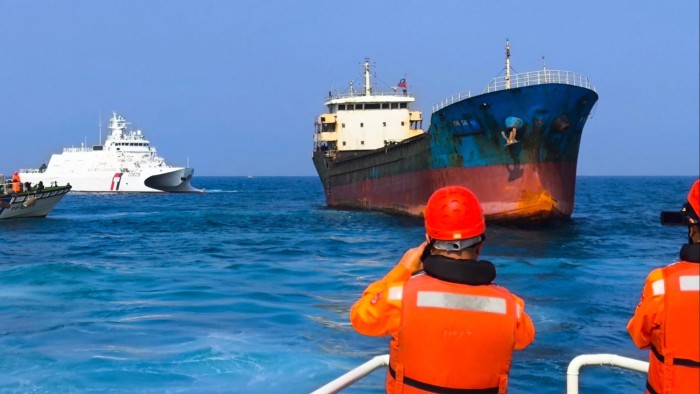Unlock the Editor’s Digest for free
Roula Khalaf, Editor of the FT, selects her favourite stories in this weekly newsletter.
Taiwan’s coastguard said it caught a Chinese-owned freighter in the act of cutting a subsea communications cable off its western coast early on Tuesday, the first encounter since Taipei launched a crackdown on Beijing’s so-called shadow fleet.
The coastguard said that it had detained the ship, adding that while it was unclear whether the cable had been severed intentionally, “it cannot be excluded that this was an act of Chinese greyzone harassment”.
The case is the latest in a series of incidents in recent months of subsea cables being severed, apparently involving Chinese or Russian-owned freighters, including in the Baltic Sea.
In November, a Chinese bulk carrier passed over two data cables in the Baltic Sea around the time they were cut, while the previous October, a Hong Kong-registered container ship was tracked near a damaged gas pipeline and cable in the region.
Early last month, another Chinese-owned ship was suspected of damaging a transpacific cable off Taiwan’s north coast after criss-crossing the area.
That incident pushed Taipei into action, driven by concerns that China, which claims Taiwan as its territory and threatens to annex it by force if necessary, could use commercial vessels to harm the country.
Beijing has stepped up such “greyzone” operations, which fall short of outright war, in recent years, including aerial and naval manoeuvres around Taiwan, cyber attacks and harassment by its coastguard and maritime militia.
In reaction to the cable damage incident in January, Taiwan’s government drew up a blacklist of Chinese-owned vessels that it said it would track and crack down on more proactively in an effort to expose and disrupt Beijing’s “shadow fleet”.
According to the coastguard, the ship detained on Tuesday, which identified itself as Hong Tai 168, was flying under the flag of Togo. It had been loitering since Saturday evening near Tainan, in south-western Taiwan, half a nautical mile north of a cable connecting the Penghu archipelago with the Taiwanese mainland.
After the ship failed to respond to seven consecutive radio messages asking it to leave, the coastguard dispatched a vessel and discovered that the freighter had lowered its anchor.
When the coastguard arrived, the freighter began to move. Shortly after, the coastguard received notice from Chunghwa Telecom, the state-owned operator, that a cable had been damaged.
The vessel appeared to be one of hundreds of ageing, dilapidated cargo ships that fly flags of convenience and hide their identity.
Shipping databases do not list a vessel named Hong Tai 168, which is the name displayed on the ship’s hull. According to its automatic identification system, it is called Hong Tai 58, the coastguard said.
The Hong Tai 58 is on Taiwan’s shadow fleet blacklist, which was seen by the FT.
However, the unique number allotted by the International Maritime Organization that the vessel was using belongs to the cargo ship Jinlong 389, owned by Hong Kong-registered Dongguan Jinlong Shipping Co, according to the IMO’s online database.
The coastguard confirmed that initial checks showed the ship was Chinese-owned.
The owners of the Jinlong 389 did not immediately respond to request for comment.
China’s foreign ministry spokesperson Lin Jian on Tuesday said he was not familiar with the incident and it was not “related to China’s diplomacy”.
The Taiwan coastguard boarded and seized the ship and brought it and its crew, which was entirely Chinese, back to port. The case has been passed to Taiwan prosecutors for investigation.
Additional reporting by Wenjie Ding in Beijing



